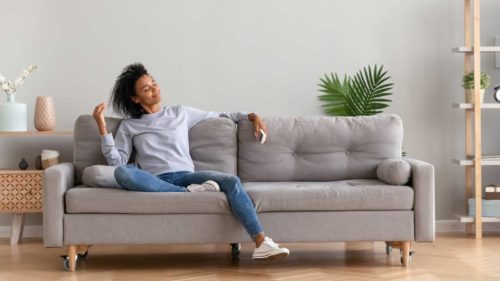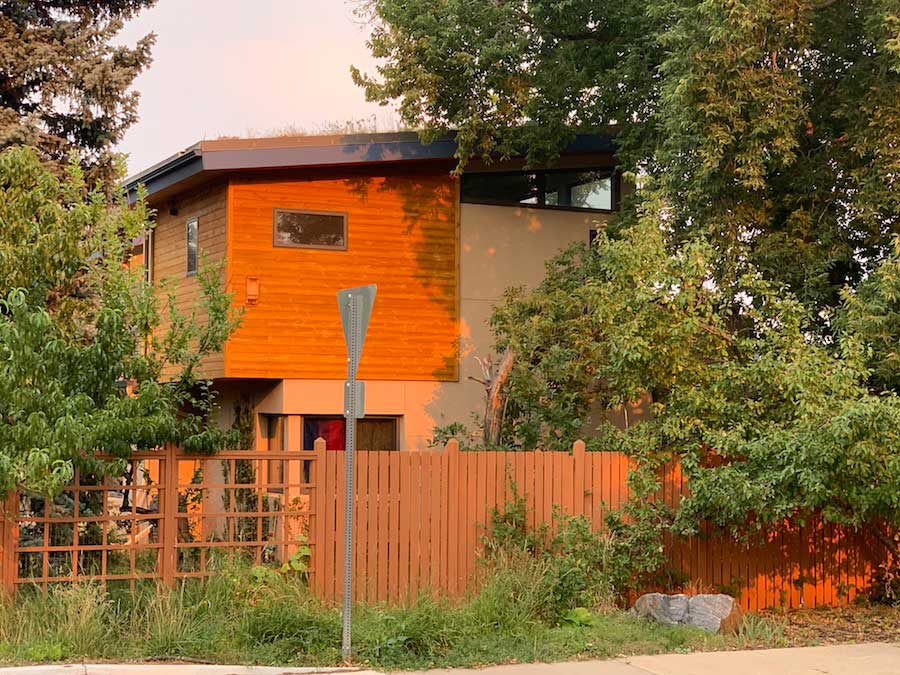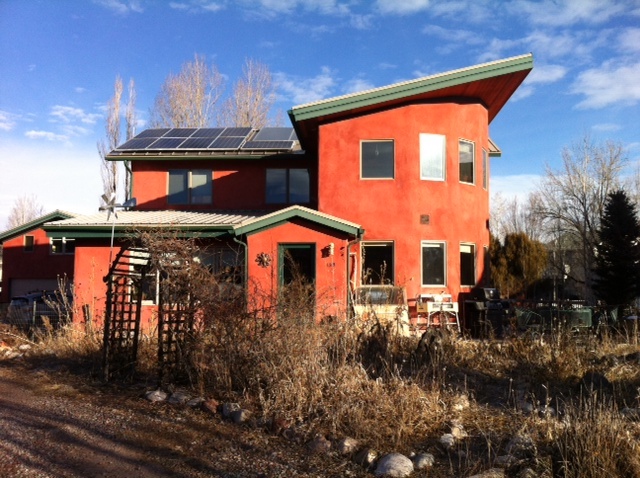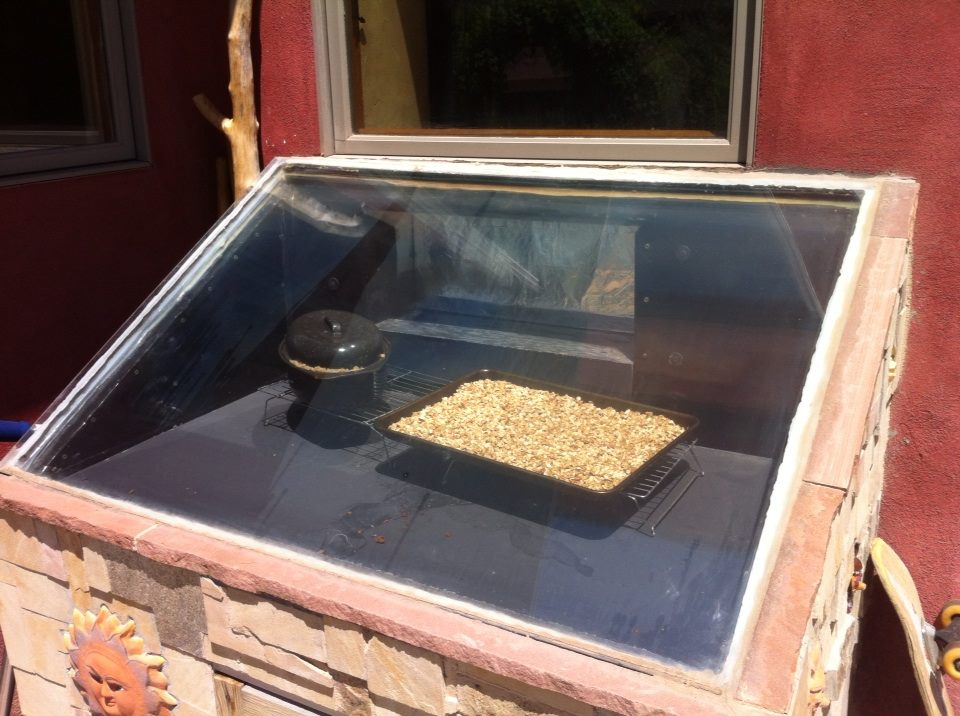African american relaxed woman sitting on comfortable couch in living room at modern home holds air conditioner remote control enjoying breathing fresh cool air at summer or warm air at winter season (African american relaxed woman sitting on comforta

How to Stay Cool while Saving Energy
As a heat wave grips much of the country, with temperatures in some areas running into the triple digits, keeping cool is critical. Yet as millions of people rely on air conditioners we run into problems.
California’s power grid operators declared a Stage 3 electrical emergency last weekend due to a number of factors including increased electricity demand. And California’s largest utility, Pacific Gas & Electric, is having to implement rolling blackouts throughout its service area as there is not enough energy to meet the high demand. Fortunately, there are some simple ways to keep your house cool with passive strategies that help save energy, money, and carbon emissions.
There are three main steps to allow your house to become a refuge in the searing heat: 1) protect it from heat gain, 2) naturally ventilate, and 3) use “cooler” interior surfaces. And if you do need to provide additional cooling, do it in the most efficient way possible.
1. Avoid the Heat Gain
The first step in keeping your house cool is to not let it get hot in the first place. That might sound like common sense, but many homes are built without some simple strategies that can help do that. For example, shading the house on the western and southern sides with trees and plants to shade windows on the exterior can make a huge difference in the amount of radiative heat reaching the house. And for the sun’s rays that do get through to the walls, lighter colored materials on building facades will help reflect that radiation and keep it from entering the house.
Investing in good energy star rated windows is another key way to keep the sun from warming up the inside of the house. And then shading those windows with overhangs will help keep the summer sun out. If overhangs are not possible, then installing light-colored interior shades will make a big difference.
There are also interior sources of heat such as stoves and showers. Venting out the heat from an oven or stove and using it sparingly can keep it from heating up the kitchen. And using a shower fan to get hot humid air out of the bathroom can help reduce the amount of heat gain happening inside the house.
2. Natural Ventilation
Naturally ventilating your home may be one of the simplest and cheapest ways to keep your house cool. Of course, it may not be possible in very hot or hot and humid places, but in places with large diurnal temperature swings, such as we have in Colorado, it’s a perfect solution. By opening up your windows at night once it cools down and closing them first thing in the morning, you can do a “night flush” bringing in fresh cool air, while venting out the warm stale air.
You can even put a fan in your window to try to draw more air in, and open windows on opposite sides of rooms to get cross ventilation. If you are doing this on the first floor and are worried about theft or break ins through open windows, you can easily install security systems on the window screens.
The benefits of a night flush assume that the air outside is not only cooler than the air inside, but also cleaner. Closed houses tend to concentrate indoor air pollutants, such as radon, formaldehydes, oxides, and dust. Flushing out these contaminants can keep your home air healthier. However, if you live in a heavily polluted city or are surrounded by forest fires, as we are right now in Colorado, it might not be the best solution.
3. Focus on Interior Comfort
If a night flush isn’t feasible, there are other ways to improve interior comfort. Air movement helps a lot, which means using ceiling fans or standing fans. Even changing the interior furnishings and fabrics can make a difference. Removing or reducing the amount of heavy fabrics and carpets can provide more radiant surfaces which will give the house a cooler feeling.
If You Just Need Cooling
Sometimes there’s no way around it, you just need cooling. If so, try to be as efficient as possible. Efficient cooling systems include evaporative cooling such as a swamp cooler if you are in a dry climate, and ductless heat pump systems in all climates. A ductless heat pump system pulls heat from a room to make it cooler and can also pump heat in from outside to make it warmer. Best of all, heat pumps require very little electricity to operate.
When your home is cool inside and you want to keep it that way, another great option is to use a heat recovery ventilator (HRV). An HRV pushes your used cool air to the outside and draws in fresh air from outside. The HRV efficiently “recovers” almost all the energy from the cool inside air to precool and dehumidify the warm moist outside air. This means that whatever you are using to cool the air inside your home doesn’t have to work as hard.
Our Houses: Case Studies in Net Zero and Super Insulation
We have two great case studies in our houses. Victor retrofitted his 1955 Boulder, Colorado, ranch home to use 83 percent less energy than a typical home, and with the addition of solar PV his house consumes net-zero energy from the utilities.
In 2010, the 1,200 square foot home started feeling too cramped for his growing family, so they added a 900 square foot second floor. The renovated house now has generous south-facing windows with overhangs calculated to provide passive solar heating in the winter and shading in the summer. They used light-colored energy star rated asphalt shingles on the roof to help reflect the heat. And they take advantage of Boulder’s temperature swings, opening the windows at night to let the cool night air in and closing them during the heat of the day.
During the retrofit, they added a lot of insulation to all exterior walls and replaced the windows with high-performance windows operated with casements or awnings, so they lock airtight when they want them to, and catch the wind when open for increased ventilation.
More recently, Victor added two small point source heat recovery ventilators that bring fresh air into the airtight house, filter it, and cool it with the outgoing cool air. On a recent day when it was 103°F outside, Victor’s house was 80° with no air conditioner running at all. And with his 10 kW solar PV system, his family doesn’t pay an electric bill.
In 2005, Laurie built her house in the mountains of western Colorado to be passively heated and cooled from the start. Like Victor, she has large south-facing windows with overhangs to shade the house in the summer and a light-colored metal roof. But perhaps most importantly, the house is built out of straw bales, which provide super insulation (with an R value from R-30 to R-45).
Laurie has adobe floors and natural plaster on the walls, which add thermal mass to the house. Thermal mass absorbs and stores heat, which helps to passively cool the home. She also performs a night flush during the summer months to bring in the cool mountain air.
One unique aspect of Laurie’s home is her solar oven built into the south wall of the house. She cooks everything from rice and vegetables to cookies and pies in the oven, keeping her from using the gas oven and keeping the heat out of the kitchen. Like Victor’s house, Laurie’s house stays cool all summer long with no air conditioning, even when the temperature gets into the mid-90s.
Most of the above suggestions are “passive” measures to keep cool, meaning that they work without using electricity, and do not add to the already stressed electric utility loads. As blackouts roll across California and temperatures break records across the country, let’s do what we can to keep cool. But let’s do it efficiently, not only saving energy, but saving money and carbon emissions as well.



